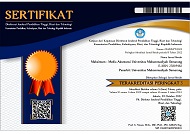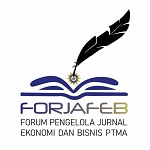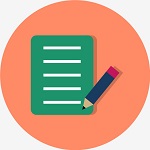What is The Company's Motivation for Doing CSR? An Analysis of Manufacturing Companies
(1) Universitas Muhammadiyah Semarang
(2) Universitas Muhammadiyah Yogyakarta
(3) Universitas Islam Sultan Agung
(4) Universitas Muhammadiyah Semarang
(5) Universitas Muhammadiyah Yogyakarta
(6) Universitas Islam Sultan Agung
(*) Corresponding Author
Abstract
Disclosure of CSR in Indonesia is still relatively low. Several companies in Indonesia Empirically, this research examines various factors that motivate companies to disclose CSR. We use profitability, earnings management, leverage, and foreign ownership predictors. The unit of analysis used was 104 of 52 manufacturing companies in Indonesia, the unit of analysis was selected using purposive sampling. Testing between variables with multiple linear regression. The study results show that the more significant profit the company generates will encourage it to disclose CSR as a form of responsibility and maintain its image. Then, a high level of debt will reduce the amount of CSR disclosure because the company has a burden component that must be paid. Lastly, earnings management and foreign ownership are not predictors of companies conducting earnings management.
Keywords
Full Text:
PDFReferences
Abdu, E. (2022). Financial distress situation of financial sectors in Ethiopia: A review paper. Cogent Economics and Finance, 10(1). https://doi.org/10.1080/23322039.2021.1996020
Ananzeh, H., Al Shbail, M. O., Al Amosh, H., Khatib, S. F. A., & Abualoush, S. H. (2022). Political connection, ownership concentration, and corporate social responsibility disclosure quality (CSRD): empirical evidence from Jordan. International Journal of Disclosure and Governance, 0123456789. https://doi.org/10.1057/s41310-022-00167-z
Arighi, R. A., Setyawan, H., & Isnanda, R. G. (2020). Designing a Fun English Vocabulary Card Application as a Means of Learning English Vocabulary for Elementary School Students. Emerging Information and Technologi, 1(3), 119–125. https://doi.org/10.18196/eist.v1i3.13173
Barwinska-Sendra, A., Garcia, Y. M., Sendra, K. M., Baslé, A., Mackenzie, E. S., Tarrant, E., Card, P., Tabares, L. C., Bicep, C., Un, S., Kehl-Fie, T. E., & Waldron, K. J. (2020). An evolutionary path to altered cofactor specificity in a metalloenzyme. Nature Communications, 11(1). https://doi.org/10.1038/s41467-020-16478-0
Belay, D. G., & Jensen, J. D. (2022). Quantitative input restriction and farmers’ economic performance: Evidence from Denmark’s yellow card initiative on antibiotics. Journal of Agricultural Economics, 73(1), 155–171. https://doi.org/10.1111/1477-9552.12439
Broniatowska, P., & Strawiński, P. (2021). Foreign- and domestic firm ownership and its impact on wages. Evidence from Poland. European Journal of Industrial Relations, 27(4), 445–466. https://doi.org/10.1177/0959680121996675
Carrasco, R. S. M., & Sicilia-Urbán, M. Á. (2020). Evaluation of deep neural networks for reduction of credit card fraud alerts. IEEE Access, 8, 186421–186432. https://doi.org/10.1109/ACCESS.2020.3026222
Christanty, L., Maharani, B., Nugroho, W. S., & Nurcahyono, N. (2023). Accounting Information Systems and Financial Literacy impact on SMEs ’ Performance. MAKSIMUM: Media Akuntansi Universitas Muhammadiyah Semarang, 13(1), 59–69.
Engelhardt, N., Krause, M., Neukirchen, D., & Posch, P. N. (2021). Trust and stock market volatility during the COVID-19 crisis. Finance Research Letters, 38, 101873. https://doi.org/10.1016/j.frl.2020.101873
Fitzgerald, R., & Kang, J. W. (2022). Transforming Korean business? Foreign acquisition, governance and management after the 1997 Asian crisis. Asia Pacific Business Review, 28(1), 111–129. https://doi.org/10.1080/13602381.2021.1972612
Floetgen, R. J., Mitterer, N., Urmetzer, F., & Böhm, M. (2021). Platform Ecosystem Structures: Leveraging Platform-based Technology and the Finance Ecosystem for the New Normal. Pasific Asia Conference on Information Systems (PACIS), July, 1–14. https://www.researchgate.net/profile/Rob-Floetgen/publication/352561767_Platform_Ecosystem_Structures_Leveraging_Platform-based_Technology_and_the_Finance_Ecosystem_for_the_New_Normal/links/60e814070fbf460db8f3057a/Platform-Ecosystem-Structures-Leveraging
Hapsoro, D., Wicaksono, C. A., & Primaretka, T. A. (2020). Does CSRD moderate the effect of financial performance on stock return? Evidence of Indonesian mining companies. Jurnal Akuntansi & Auditing Indonesia, 24(1), 1–10. https://doi.org/10.20885/jaai.vol24.iss1.art1
Indarti, M. G. K., Widiatmoko, J., & Pamungkas, I. D. (2020). Corporate Governance Structures and Probability of Financial Distress: Evidence From Indonesia Manufacturing Companies. International Journal of Financial Research, 12(1), 174. https://doi.org/10.5430/ijfr.v12n1p174
K., S., & Hari, H. (2021). Measuring the Performance Efficiency of State Bank of India and HDFC Bank using Balanced Score Card. SDMIMD Journal of Management, 12(2), 11. https://doi.org/10.18311/sdmimd/2021/26371
Khairani, R., Haikal, M. F., Ramadhani, S., Gustia, N., & Sitompul, F. R. A. F. (2020). Pengaruh Debt to Equity Ratio,.Earning Per Share,.dan.Net Profit Margin Terhadap Harga Saham pada Industri Manufaktur Konsumsi Makanan dan Minuman. Journal of Economic, Bussines and Accounting (COSTING), 4(1), 90–95. https://doi.org/10.31539/costing.v4i1.1349
Khasanah, S. N. U., & Nurcahyono, N. (2021). Capacity, Pengaruh Operating Growth, Sales Dan, Arus K A S Terhadap, Leverage Distress, Financial. Jurnal Sustainable, 2(2), 357–371.
Kirer Silva Lecuna, H., & Caliskan, M. M. T. (2020). The Determinants of Banking Sector Profitability in Turkey. Business and Economics Research Journal, 11(1), 161–167. https://doi.org/10.20409/berj.2020.242
Lacin, H., Williamson, W. R., Card, G. M., Skeath, J. B., & Truman, J. W. (2020). Unc-4 acts to promote neuronal identity and development of the take-off circuit in the drosophila cns. ELife Research Article, 9, 1–27. https://doi.org/10.7554/eLife.55007
Magda, I., & Sałach, K. (2021). Gender pay gaps in domestic and foreign-owned firms. Empirical Economics, 61(4), 2237–2263. https://doi.org/10.1007/s00181-020-01950-z
Masoud, N., & Vij, A. (2021). Factors influencing corporate social responsibility disclosure (CSRD) by Libyan state-owned enterprises (SOEs). Cogent Business and Management, 8(1). https://doi.org/10.1080/23311975.2020.1859850
Mat, N. K. N., Sulaiman, Y., Ghani, N. H. A., & Mohamad, M. (2018). Halal consumption pattern determinants: Sequential mediating effects of Muslim lifestyle, trust and risk perception. Journal of Social Sciences Research, 2018(Special Issue 6), 444–453. https://doi.org/10.32861/jssr.spi6.444.453
Michalak, P., Szczotka, K., & Szymiczek, J. (2021). of Thermal Modernization of a School Building. Energies Article, 14.
Mohd Sofian, F. N. R., & Muhamad, R. (2020). Modified integrated Islamic CSRD index and financial performance of Malaysian Islamic banks: Stakeholders’ perception. Journal of Islamic Accounting and Business Research, 11(8), 1599–1617. https://doi.org/10.1108/JIABR-10-2018-0158
Nurcahyono, N., Hariadi, B., & Mardiati, E. (2019). The Effect of Work Loads on Employee Performance With Job Satisfaction As A Mediation Variable. Journal of Business Management and Economic Research, 3(8), 40–49. https://doi.org/10.29226/tr1001.2019.147
Nurcahyono, N., & Sinarasri, A. (2023). Earnings Management as an Finance Strategy for Company Image. Jurnal Proaksi, 10(3), 337–351. https://doi.org/10.32534/jpk.v10i3.4476
Nurcahyono, N., Sukesti, F., & Alwiyah, A. (2021). Covid 19 Outbreak and Financial Statement Quality: Evidence from Central Java. AKRUAL: Jurnal Akuntansi, 12(2), 193-203.
Nurcahyono, N., Sukesti, F., & Haerudin, H. (2022). The Effect of Good Corporate Governance Mechanisms, Financial Ratio, and Financial Distress: A Study on Financial Companies. ICBAE. https://doi.org/10.4108/eai.10-8-2022.2320848
Pernamasari, R., Nur Fitria, G., & Ahmad, N. H. (2020). The Impact of The CG Scorecard on Earning Management with Firm’s Characteristics as a Variable Intervening. South Asian Research Journal of Business and Management, 2(3), 30–37. https://doi.org/10.36346/sarjbm.2020.v02i03.001
Proctor, S. L. (2022). Rewarding recovery: the time is now for contingency management for opioid use disorder. Annals of Medicine, 54(1), 1178–1187. https://doi.org/10.1080/07853890.2022.2068805
Rahma, A. M., Nurcahyono, N., & Sinarasri, A. (2022). Moderating Effects of Institutional Ownership on the Relation Between Capital Structure. International Conference on Business, Accounting, Banking, and Economics, 1, 293–306. https://doi.org/10.2991/978-94-6463-154-8
Sheraz, M., Ullah, A., Ullah, S., & Irfan Khadim, M. (2021). Islamic Credit Card: A New Version of Sharia Compliant Credit Card. International Journal of Information, Business and Management, 13(4), 2021.
Sukesti, F., Almasyhari, A. K., Jamil, N. N., & Marzuki, A. (2022). IFRS Convergence and Disclosure Quality: The Role of Audit Quality Moderation (Study on Multinational Companies in Indonesia).
Sukesti, F., Ghozali, I., Fuad, F., Almasyhari, A. K., & Nurcahyono, N. (2021). Factors Affecting the Stock Price: The Role of Firm Performance. Journal of Asian Finance, Economics and Business, 8(2), 165–173. https://doi.org/10.13106/jafeb.2021.vol8.no2.0165
Tang, L., Zhao, Y., Tsui, K. L., He, Y., & Pan, L. (2020). A clustering refinement approach for revealing urban spatial structure from smart card data. Applied Sciences (Switzerland), 10(16). https://doi.org/10.3390/app10165606
Tarighi, H., Appolloni, A., Shirzad, A., & Azad, A. (2022). Corporate Social Responsibility Disclosure (CSRD) and Financial Distressed Risk (FDR): Does Institutional Ownership Matter? Sustainability, 14(2). https://doi.org/10.3390/su14020742
Tharani, J. S., & Arachchilage, N. A. G. (2020). Understanding phishers’ strategies of mimicking uniform resource locators to leverage phishing attacks: A machine learning approach. Security and Privacy, 3(5), 1–15. https://doi.org/10.1002/spy2.120
Visser, K., Swart, G., Pretorius, J., Esterhuyzen, L. M., Verster, T., & Fourie, E. (2022). Customer comfort limit utilisation: Management tool informing credit limit-setting strategy decisions to improve profitability. Cogent Economics and Finance, 10(1). https://doi.org/10.1080/23322039.2022.2056362
Article Metrics
Abstract view : 301 timesPDF - 22 times
DOI: https://doi.org/10.26714/mki.13.2.2023.209-217
Refbacks
- There are currently no refbacks.
-----------------------------------------------------------------------------------------------------------------------------------------------------------------------------------
 | MAKSIMUM: Media Akuntansi Universitas Muhammadiyah Semarang |
![]()
Maksimum: Media Akuntansi Universitas Muhammadiyah Semarang is licensed under a Creative Commons Attribution Attribution-NonCommercial-NoDerivatives 4.0 International License.

















